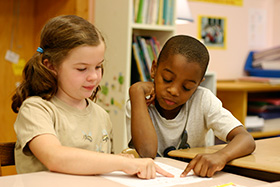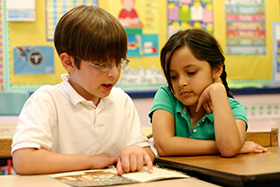What types of activities can the teachers at Washington Elementary use to increase their students’ reading skills?
Page 5: Pair Students
The teachers at Washington Elementary have learned that PALS systematically pairs students so that each dyad consists of one higher-performing reader and one lower-performing reader. For both kindergarten and first grade, the teacher ranks his or her students based on reading performance. Because students in early grades have limited reading skills, many researchers and teachers use the Rapid Letter Naming (RLN) test, a measure of letter recognition and a fairly reliable measure of future reading performance. However, the method of pairing students for each of these two grade levels is somewhat different. See the examples below to learn more about each.
Kindergarten

The teacher pairs the highest-performing student with the lowest-performing one. The teacher then pairs the next highest-performing student with the next lowest-performing student, and so on until all students have been paired. Click here for an illustration of how Mrs. Doris uses this method to pair her kindergarten students.
First grade

The teacher divides the rank-ordered list in half and pairs the top high-performing student with the top low-performing one (and this might include pairing a student with a disability [e.g., learning disability in reading, intellectual disability] with one without a disability). The process continues until all of the students have been paired. Click here to see an illustration of how Ms. Chandler uses this method to pair her first-grade students.
Pair Kindergarten Students
Step 1: Rank the students
Although there are several options available for determining students’ prereading skills, Mrs. Doris ranks her students based on their performance on a Rapid Letter Naming (RLN) test.
|
|
Step 3: Move the halves next to each other
Rearrange the order of the students in the lowest performing column so that the lowest-performing student is at the top. Pair the highest-performing student with the lowest-performing student. Continue this process until all of the students have been paired.
|
|
|
|
||||||||||||||||||||||||||||||||||||||||||||||||
(Close this panel)
Pair First-Grade Students
Step 1: Rank the students
Although there are several options available for determining students’ reading skills, Ms. Chandler ranks her students based on their performance on a Rapid Letter Naming (RLN) test.
|
|
Step 3: Move the halves next to each other
Arrange the two halves side-by-side and pair the higher-performing student in the first column to the corresponding lower-performing student in the second. Continue this process until all of the students have been paired.
|
|
|
|
||||||||||||||||||||||||||||||||||||||||||||||||
(Close this panel)
Students remain with the same partner for approximately four weeks. After that time, each of them is paired with another student based on performance as well as a number of other pertinent considerations, such as the students’ social skills and their individual learning needs. Of course, student pairs may be changed at any time if a pairing proves unsuccessful. The table below outlines several reasons that student pairs might need to be altered, either temporarily or permanently.
| Reason | Example |
| Student academic needs | The discrepancy in the students’ abilities is too large to accommodate learning. |
| Behavior issues | The student pair has difficulty following instructions and the PALS rules, creating a disruptive environment. |
| Student incompatibility | The stronger reader does not work well with the struggling one, showing disrespect or offering inappropriate feedback. |
| Absenteeism | One student is absent for the day. Click here to learn about ways to adjust pairs when students are absent. |
|
Adjusting Pairs When Students Are Absent Teachers should plan ahead for how student absenteeism will affect their PALS sessions. Below are several recommendations to ensure that all students can engage in a reading activity even in the event that one or more students are not present.
|
|
Devin Kearns discusses considerations when pairing kindergarten students (time: 0:29).

Transcript: Devin Kearns, MA
The most important thing in kindergarten is behavior, and so pair up the students who you think will get along really well. In kindergarten, most of the kids come at the same level. They don’t start to differentiate themselves in terms of ability for some weeks, and that’s okay because at the beginning the activities are pretty simple and there’s not a huge demand. You will start to notice very quickly which students are having more difficulty keeping up, and so, after the first few weeks, you can make some decisions about pairing.
For Your Information
 It is often the case that a classroom contains an odd number of students, leaving one student without a partner. In such an instance, teachers may need to create a group of three students (a triad). When such a grouping becomes necessary, teachers might wish to keep the following considerations in mind:
It is often the case that a classroom contains an odd number of students, leaving one student without a partner. In such an instance, teachers may need to create a group of three students (a triad). When such a grouping becomes necessary, teachers might wish to keep the following considerations in mind:
- Each student can serve as the Coach for one of the three activities and the Reader for the remaining two.
- One student with average or above reading and social skills can be assigned to a triad but serve as a “floater,” filling in for other students when they are absent.
- It is better to place higher- or average-performing students in triads than it is to assign struggling readers to these groups because students in triads have fewer opportunities to practice their reading.